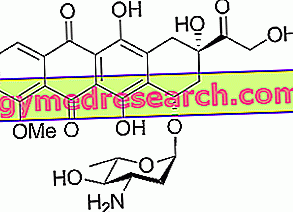The omega 6
Omega6 are essential fatty acids (AGE); their structure is polyunsaturated, ie it has two or more double bonds that make them liquid both at room temperature and at more rigid temperatures.
The English acronym of essential fatty acids is PUFA, which derives from the specific nomenclature Poly-Unsaturated Fatty Acids (PUFA), or rather, in the case of omega6, PUFA-n6.

The omega6 are the basis of the synthesis of some bioregulators: prostaglandins and thromboxanes. Since they are precursors involved in inflammatory processes and blood coagulation, some researchers have carried out in vitro tests to verify their potential harmfulness to humans at pharmacological doses; the results were not encouraging. However, only later, other experimental and statistical in vivo have denied these theories and on the contrary increasingly assimilate the metabolic effects of linoleic acid (precursor of omega6) to those of the other beneficial and free of side effects AGE, i.e. α-linolenic acid (PUFA-n3).
Sources of omega6 (ω6)
Linoleic acid is available mainly in seeds, nuts and oils. They are excellent sources of omega6: sunflower oil, wheat germ and wheat germ oil, sesame, walnuts and walnut oil, soybeans and soybean oil, corn and corn oil, olives and olive oil, etc.
Levels of intake of omega6 (ω6)
To hear what the Recommended Nutrient Intake Levels for the Italian population (LARN) cite, the contribution of AGE should be around 2.5% of total calories (kcal), appropriately divided into 0.5% of omega 3 and 2, 0% of omega6. Ultimately, the ratio between omega6 and omega3 should be 4: 1 and in any case not exceed 6: 1. Based on the statistical data obtained from the research on a large sample, it was estimated that, in the Italian diet, the ratio between omega6 and omega3 is between 10: 1 and 13: 1; on the other hand, this does not mean that the intake of omega6 reaches the recommended values (let alone that of omega3) and that the overall assumption of AGE can be defined as satisfactory.
We are what we eat: interaction of nutritional molecules with the organism
An old saying by the German philosopher Ludwig Feuerbach cites: "... we are what we eat ... "; nothing more true.
The lipid and protein content of our tissues also depends on the nutritional molecules we take with the diet; it is also true that the organism, except for the essential molecules (vitamins, mineral salts, essential amino acids and AGE), synthesizes autonomously the "bricks" that constitute the organism ... but it is not always so efficient! Just think of the food contamination from prions, peptide sequences that, by changing their structure suddenly, alter the structure of the protein they go to (see Bovine Spongiform Encephalopathy - BSE, or mad cow syndrome); animals and humans, feeding on meat infected with prions and not properly cooked, can contract this disease. Another striking example is that referring to the direct correlation between content in saturated fatty acids, hydrogenated and in trans VS conformation, reduction of mental efficiency and predisposition to degenerative cerebral diseases (Alzheimer) in the third age. It seems that an excessively rich diet of these "nutrients" interacts on the composition of nerve cells significantly worsening the overall efficiency.
It goes without saying that it is absolutely essential to manage your diet in a healthy and intelligent manner; unfortunately, however, often our "choices" are limited to a superficial level, that is the food group: those who want to introduce more good fats and less bad fats tend to eat more fish and vegetable oils than food derived from terrestrial animals (such as cheese and fat pork meat). The reader does not misunderstand, it is an excellent interpretation of the "guidelines" and for no reason must change it; however, it can be helpful to reach a new level of awareness regarding the distinction of various foods based on the origin and / or race they belong to.
Content of omega6 (ω6) in the pig, the Nero delle Mandonie
From what is written in the introduction, it seems that the essential fatty acids of the omega6 category are exclusive to foods of vegetable origin (seeds, sprouts and derived oils), but in the following paragraph we will discover that there are some welcome exceptions.
" We are what we eat " is a saying that concerns all forms of life, including the animals of our farms; therefore, it should be deducible that the meat of the animals destined for slaughter could be more or less healthy based on the diet and lifestyle that these animals have followed (or followed) over the course of their lives.
As regards the composition of lipids in meat, in addition to the type of farming (intensive or extensive), nutrition also plays an important role. Obviously, we are all aware that some chemical and nutritional aspects are impossible to change; for example, the cholesterol content of meat (which cannot fall below a certain level, being a constituent of cell membranes), or the content (moderate) of fatty acids in a trans configuration present in the tissues of ruminant animals (which originate from the intestinal bacterial fermentation). However, there are breeds of BREEDED animals that contain a high intake of AGE and a smaller quantity of saturated ones, by virtue of a completely natural diet, therefore HEALTH; this is the " Sicilian black pig of the Nebrodi, or Nero delle Mandonie" .
In reality, it is not the only ALLEVATA species (thus excluding wild beasts) that has such a lipid content; also in other European countries (such as Spain) you can find farms that produce meat similar to those of the Nero delle Mandonie, but "by parochialism", in the paragraph that follows, we will focus on Italian farms.
The Nero dei Nebrodi pig is an ancient native breed of Sicily and its presence on the territory can be traced back to the Greek and Carthaginian period (VII-VI century BC); it is a dark colored pig with an almost totally wild behavior that requires free and independent pasture. The breeding of the Nero delle Mandonie takes place in the wooded areas of the island, on the Nebrodi precisely, an area that is located in the only green Apenine-like spot in Sicily: the slopes of Etna . This pig reaches considerable dimensions and generally is in groups of 10-15 specimens; graze and grufola in patches composed of oaks, oaks and beeches, in which it can find mushrooms, tubers, roots, bulbs, hazelnuts and acorns in abundance.
With regards to its diet, the Nebrodi black pig boasts an excellent omega6 content; more than from tubers, roots, bulbs and mushrooms, this animal obtains the essential fatty acids from the continuous introduction of acorns and hazelnuts. It is a diet closer to that of the wild relative, the wild boar, and less similar to that of the breeding brother (consisting of flour and feed of all kinds); this characteristic gives the Nero delle Mandonie an unparalleled nutritional richness.
In conclusion, to favor the supply of omega6 fatty acids also with pork (having the possibility), it would be advisable to prefer meat (both fresh and preserved) obtained from the slaughter of pigs from Nero delle Mandonie farms, a breed equipped with a registry and officially recognized by the National Association of Swine Breeders (ANAS).



